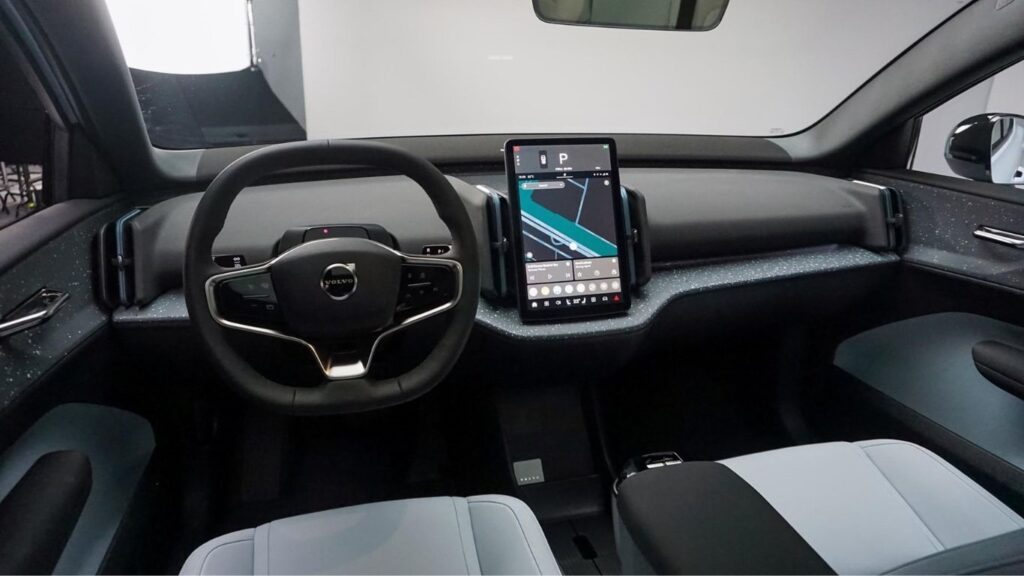It marks a shift toward an affordable, mass-market EV
Volvo entered the modern era with a bang about ten years ago. Literally. The second-generation XC90 crossover, which debuted in 2015, helped change the perception of a brand formerly associated with boxy station wagons by providing cutting-edge hybrid engines, eye-catching styling, and a sizable tablet centre screen that felt from out of the Tesla playbook.
Now, the car that’s poised to be Volvo’s next big hit is actually pretty small — and affordable, too.
The EX30, which made its North American debut in New York last month, is a car full of firsts. Volvo’s first tiny completely electric crossover is the company’s fastest car yet, with an inventive, yet less expensive interior constructed of sustainable materials – a combination the automaker feels is critical to converting the EX30 into a mass-volume, popular hit.
In short, this tiny car is significant for Volvo and represents a significant evolution of the brand. And it’s already making a big impression.
“The overall reception has been exceeding expectations, multiple times,” said David Mele, the EX30’s product manager in the United States, in an interview. “It’s been overwhelmingly favourable. We’re seeing that almost every market in which Volvo operates is quite excited about this automobile.”
Big deal for a little automobile

One important reason is the EX30’s price: It has a starting price of $34,950, making it one of the more cheap EV alternatives in the United States. In a year when electric adoption has undergone ups and downs — some critics fear demand is decreasing as EVs pile up on dealer lots — the EX30 will be significantly below the $53,000 average price tag these cars have recently commanded.
Right present, there are only a few players in America’s inexpensive EV market: There’s the Tesla Model 3 and Model Y, which are selling like hotcakes after price cuts and tax breaks; the Chevrolet Bolt, which General Motors reversed its decision to discontinue; and a few others, like the Kia Niro EV, Hyundai Kona EV, and Hyundai Kona Electric. At dealer lots, the latter two can easily exceed $40,000 in price.
Analysts argue that most consumers aren’t interested in EVs because they’re too expensive at a time when interest rates are high and the economy is uncertain. According to a recent poll conducted by data firm AutoPacific, a price tag of less than $35,000 is what it would take for many individuals to make the switch.
The EX30 is smack in the middle, undercutting even Volvo’s next-cheapest car, the tiny gas or electric XC40, by a few thousand dollars. The EX30 is approximately ten inches shorter than the XC40 and twenty inches shorter than Tesla’s world-beating Model Y crossover.
Volvo’s previous attempts at tiny automobiles have not always been successful. In the United States, the midsize XC60 is the best-selling model, followed by the larger XC90. Previous entrants, such as the tiny C30 hatchback and V50, failed to make a significant sales impact.
The EX30 is risky in many ways, but Volvo is betting on its electric engine to attract customers it didn’t have previously.
Mele stated that the EX30’s target client is “pre-family” purchasers without children or “post-family” parents and grandparents. It might be many buyers’ second or third car, as well as their first EV and Volvo. That’s quite a few people.
In sum, Volvo is striving for mass appeal with this one, which it hasn’t done very often previously. “It’s not going to be a niche product,” Mele predicted. (He declined to share EX30 sales targets.)
Swedish origins, Chinese manufacturing
Scale is consistent with Volvo’s aspirations of turning “half-electric” by 2025 and all-electric by 2030, according to Mele. However, it is also an important component of activities spearheaded by Volvo’s Chinese parent firm, Geely Holding Group. With Volvo, Polestar, Lotus, and several EV-focused brands not marketed in America like Lynk & Co, Geely is fast emerging as the Chinese auto conglomerate trying to take over the world – potentially even without its consumers recognizing it.
In truth, the EX30, like only a few other automobiles sold in the United States these days, will be manufactured in China. That means it won’t be eligible for any tax breaks in the United States, and it will be subject to a 27.5% tariff on Chinese-made automobiles, making the price tag even more astounding. (“Anything we have to pay to the government is accounted for in that price,” Mele added, declining to comment on the car’s possible profitability.)
Mele stated that Volvo is still deciding where the car would be made in the long run.
While Volvo will not comment further, it is possible that the corporation will follow the lead of other competitors and locate production in North America. Volvo is already expanding its South Carolina plant to accommodate the production of its flagship EX90 electric crossover. “Our long-term goal is to build cars where we sell,” Mele explained. “Not only is this good for manufacturing, but it also reduces carbon emissions.”
Of course, other markets aren’t as tough on China tariffs. However, at a time when European manufacturers are anxious about lower-cost Chinese cars cutting into their market share on their native turfs, Volvo is one European brand that may be able to have its kladdkaka and eat it as well.
Specifications that are important

While Americans have generally been wary of Chinese-made vehicles because to prior impressions and political issues, the EX30 may be enough of a deal to test how much we care; the long-held Swedish brand identification may assist.
The EX30 comes with two battery packs: a 69 kWh nickel-cobalt-manganese pack for North America and a 51 kWh lithium-iron-phosphate pack for foreign markets. The EX30 comes with two powerplant options. The base model is a single-motor, rear-wheel drive vehicle with 272 horsepower and a range of 275 miles. That model accelerates from 0 to 60 mph in 5.7 seconds. Upgrading to the Twin Motor Performance model adds dual motors for all-wheel drive and 422 horsepower, as well as a 3.4-second zero-to-60-mph time. According to the manufacturer, no Volvo has ever been as speedy out of the plant.
Its 12.3-inch vertical touchscreen, which, like a Tesla, controls practically all main control interfaces because there’s nothing in front of the driver, runs the most recent version of Google’s Android operating system. Wireless Apple CarPlay is also included, as is wireless phone charging, standard 5G connectivity, over-the-air software updates, four USB-C ports, and the ability to charge from 10% to 80% in 26.5 minutes, according to Volvo.
In other words, despite being small and inexpensive, it does not appear to be a penalty box economy car. It also comes in some interesting colours, such as Cloud Blue and the very bold (for Volvo) Moss Yellow. The EX30 is set to hit the market next summer.
While Mele confirmed the EX30 will arrive with the normal CCS charging connector, Volvo’s models will be able to access Tesla’s Supercharger network with an adaptor starting in 2024, and that plug will be standard starting in 2025, making it even more appealing as someone’s “first EV.” Mele stated that this is exactly the intention.
“With this car, we’re sort of democratizing battery electric vehicles,” he explained.










